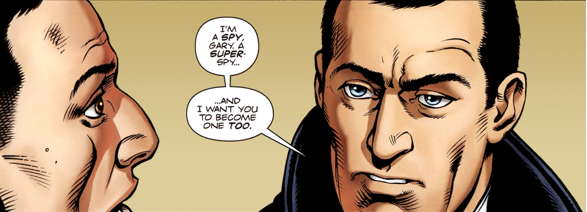
by Millar and Gibbons, from The Secret Service
1/25/19-2/1/19
All work is due by midnight on Friday, 2/1/19
Below is a detailed list of what’s to be completed this week.
- Read: The New Digital Storytelling: Creating Narratives with New Media Chapter 1, “Storytelling for the Twenty-First Century,” to start thinking about what is storytelling and what is digital storytelling. A PDF is in the Files section of Canvas.
Watch: Vonnegut on The Shape of Stories https://www.youtube.com/watch?v=oP3c1h8v2ZQ to start thinking about the structure of stories.
And…Read some more: No one becomes a good storyteller without being a good story reader. This is something we should be thinking about throughout this course. By “being a good story reader” I mean not just absorbing the tale, but also, or rather more importantly, critically examining how it is told, whether in words, images, sounds, objects, or anything else, or in any combination thereof. What makes a great book great is the use of language as much as the plot. Photography, design, audio and video all have languages of their own, and we’ll be looking at those in the coming weeks.
This week, you need to read/view one theme-related story, and analyze it. What makes it a good story? What storytelling techniques are being used effectively? I put the class suggestions into a Google Doc. You can use one from the list, or you can choose something else, if you have an example of good storytelling in mind.
Bring it all together: How do the ideas in the readings and video apply to your chosen story? Considering these and other works in the genre you know of, what themes, patterns and commonalities do you see? What defines a secret agent, or a secret agent story? What did you like about the story? What worked and what didn’t? How did the story develop character and setting? How did it hold your attention? These questions are only general suggestions to get you thinking. You will all probably have more and better ideas based on your readings. Write up your thoughts in a blog post and tag it storyanalysis. - Write a Character Dossier: Create a character dossier for a secret agent themed character of your own making. Feel free to use the TVTropes site as a resource. You can also look at the Dossier section of the Spy Museum’s Spy for a Day guide for ideas. You do not have to conform to any traditions, and you are not limited to agents themselves – you could make a character in an ancillary role. In the Bond series, for example, there is a supervisor, an office manager, and the mad scientist who makes all the gadgets. Agents of SHIELD had double agents and Hydra. Archer has an accountant and a HR person. North by Northwest had an ordinary guy who got accidentally pulled into international intrigue. Roles like those are interesting because you can make of them whatever you want. Also, this is a character you will be working on over the course of the semester, so take some time to think about this.
Fill out the Dossier form for your character.
You can also create a dossier cover page.
Write a narrative post introducing your character. This can include information from the form, but should have more details, like a back story or background intelligence, perhaps. Tag the post: characterdossier - Writing Assignments:This week, we will be using Writing Assignments from ds106’s Assignment Bank. Each assignment comes with a “star” or point rating that roughly estimates its difficulty. You must complete at least 10 stars of writing assignments. Connect at least one of the assignments in some way to our theme and/or the character you create.
Note: You can create new assignments at any time. So if you don’t like the writing assignments as they are, you are welcome to come up with a new one and do it yourself. - Daily Creates: Let’s do 3 this week.
- Commenting: You should all be following each other’s work and offering each other feedback, ideas, support and encouragement. Several people have been doing this already, which is great, but more is better. A good habit is to visit the course site every day to see what people have posted. Click through to a few posts and share your thoughts on the work, and ideas that it may inspire. We all appreciate positive feedback, and we can all be inspired by each other. This should take no more than a few minutes a day.
ALSO: Important! You need to moderate comments. In your Admin dashboard, you can go to Settings->Discussion to see Comment settings. I keep mine set to email me whenever anyone posts a comment and whenever a comment is held for moderation, and also set so that before a comment appears, the author must have a previously approved comment. This means that I get notified whenever there is a comment on one of my posts, but that I only have to approve commenters one time, and then they are free to comment without needing further approval. You can also delete any comment at any time. Commenting is one of the main ways we interact in this course, so we need to make it work. - Questions to think about:
What makes a good blog post title? A creative title? How does a title make you want to read the post?
How is writing for the web different? How does it change the way we write?
You can respond in the Slack channel for #week-three. - Write your Weekly Summary: This is an every week thing. Your summary should link to or embed all your work for the week, and give your thoughts on the week as a whole. Submit the URL for this post to Canvas by the end of the day on Friday.
